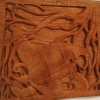Rust, corrosion, iron oxide and pitting are the natural (though sad for us!) results of moisture on iron.
The best way to avoid it is to keep your tools dry. And, of course, and use them...

| 22 October 2022 08:00
Patrick - The best way to stop your carving tools going rusty is, of course, to use them!
Having said that, I know sometimes we need to store tools longer term and - bottom line - you are looking to separate the high-carbon metal of your tools from the atmospheric oxygen.
Pretty much any mineral oil will do this and no doubt vegetable oils too - though I've never used the latter. Yes they dry as they oxidise forming a protective layer but I've always thought they also can go rancid. I've heard Camellia oil (a vegetable oil) is good, not going rancid and used extensively in Japan.

| 20 October 2022 15:07
Hello Chris, Just a question about tool maintenance, do you have some suggestion about oil to use to prevent rust? I had look on YouTube and on net, seems people mostly use mineral oil, 3 in 1 oil or WD40. On other hand knife folks use also ballistol multiporpose oil or reinaccence wax. I have also some friend that use boiled liseed oil, other suggest to put in a rag with silicon oil. I' m Little confused, can you help me?

| 12 January 2017 08:45
Rafaela - Yes, humidity easily causes corrosion in with high-carbon (non-stainless) steel tools. I have 2 thoughts for you:
I know carvers in very high humidity areas who have made de-humidifying cabinets to store tools, which is extreme, but does the job. You might think about de-humidifying the workshop?
I have also heard of carvers using Japanese Camellia Oil (Hamono Tsubaki), traditionally used to clean and protect hand saw blades, swords, knives, plane irons, chisels and many other metal objects from corrosion. It's readily available (online?). You wipe a thin protective coat onto the tools you are storing. I've no experience myself, not really having a problem with corrosion, but it would be worth a try.
BTW. It's not a cooking oil!

| 12 January 2017 04:41
Hi Chris,
Great tutorial and advice. I live in a very humid climate (in Far North Queensland, Australia) and wondered what the best way of storing my tools would be. I notice at the start you mentioned that this tool came from being stored in a tool roll, so I will avoid that. A few of my second-hand chisels already have speckles of rust on them and I want to keep them in as good condition as possible. Thanks.

| 02 August 2016 11:57
Alejandro - I only know one of these old makes: Addis, but most old tools will be worth trying. The Two Cherries is modern by the way. Maiers and Buck Bros I've never used.
Probably the most important thing is the blade length; short tools will be running out of hardness. You want at least 2 inches of blade beyond the shoulder Of course, the problem is that the most useful tools are often the one most worn down ...

| 28 July 2016 15:54
Hello again!
For lack of a better place to ask this question, I will ask it here.
I'm looking on eBay and such for chisels. It's fun and elucidating. On it, I'm seeing a lot of "antique" and "vintage" chisels. Some are beautiful others are a clearly, well used, though modern Pfeil. But, if it's a good price ($15 to $20), why not! I also see a lot of SJ or BJ Addis, C Maiers, Buck Bros, Two Cherries, etc... Aside from rust or bluing (which I haven't seen yet), how do I know what's a good antique brand and which isn't? Because, in addition to having such beautiful tools, I'd like to use them.